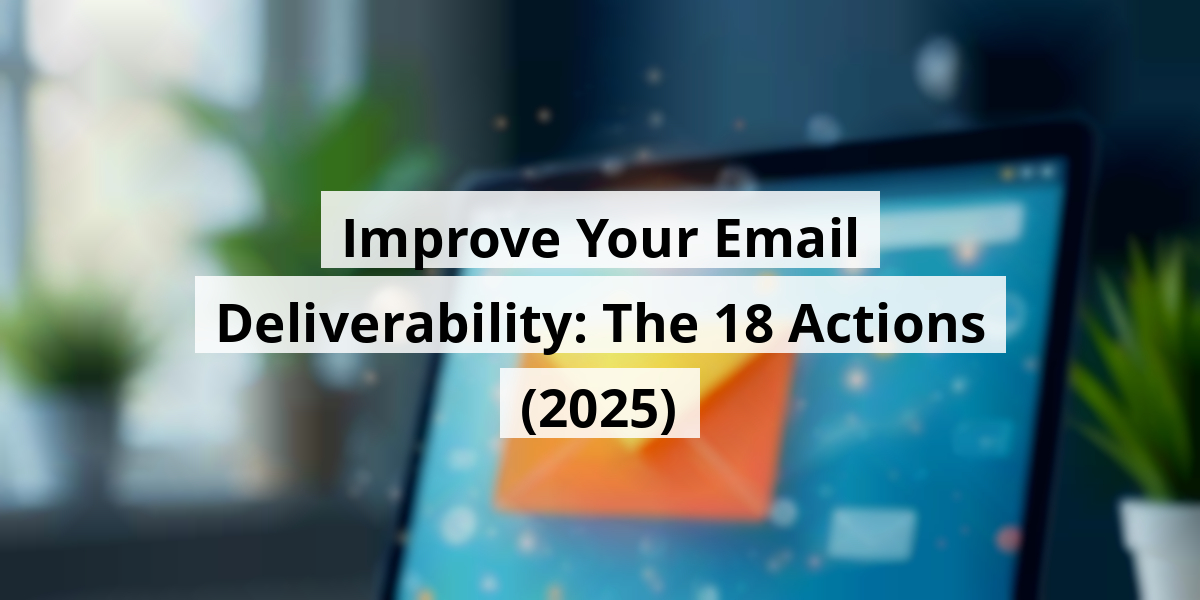 LIMITED SPOTS
All plans are 30% OFF for the first month! with the code WELCOME303
LIMITED SPOTS
All plans are 30% OFF for the first month! with the code WELCOME303

 LIMITED SPOTS
All plans are 30% OFF for the first month! with the code WELCOME303
LIMITED SPOTS
All plans are 30% OFF for the first month! with the code WELCOME303


Now we are going to talk about why we can chat about improving your email deliverability. It's like dissecting the fine art of getting your friend to let you borrow their favorite jacket without them noticing it’s missing.
Let's face it – there’s no shortage of guides on email deliverability out there. They pop up like weeds in a garden, right?
Most of these tips circle around the same tired advice, and honestly, some of it is just plain wrong. It’s like when your uncle insists that wearing socks with sandals is 'in' – it’s not!
This guide is born from real-world experience – not just theory or guesswork.
What we've put together here comes from those nuts-and-bolts experiences. Heck, we've even managed to:
In plain terms, we know our way around the email jungle, and we’re here to help you figure out how to keep those emails out of the spam folder. Because let’s be real, nobody wants their heartfelt message to end up in the same place as a dusty old sock.
This is precisely why we set out to create an effective solution to email deliverability. Our current favorites include an email warm-up tool and a nifty spam test.
And we’re committed to keeping this guide fresh, updating it to reflect the latest in the field. After all, if fashion can change overnight, so can email strategies!
We genuinely hope you’ll find these tips useful to pump up your email results and ensure your messages land right where they need to be – in the inbox!
Now we are going to discuss some vital steps to ensure your email campaigns don’t end up in the dreaded spam folder. There's a lot to consider, and we’ve got you covered.


Let’s face it; not everyone talks about the importance of a domain choice.
Domains are like real estate—location matters. Some domains get a bad rap and are automatically seen as spammy.
Choosing a domain with a spurious reputation can start your email journey on the wrong foot. Seriously, remember that one friend who always picks the worst restaurants? Don't be that friend.
Spammers have a habit of bouncing around from one cheap domain to another, leaving a trail of burnt emails much like those overcooked soufflés we all made in culinary school. They often rack up domains with names like “bestoffers-slightlylesssuspect.com.”
Here’s what we should keep in mind when picking an email domain:
Choosing the right TLD:
And here’s a quirky bonus: statistically, women get higher open rates on emails. Who knew, right? It’s like discovering that your favorite ice cream flavor actually has health benefits!
Here’s a quick refresher for those who’ve snoozed during tech class:
SPF stands for Sender Policy Framework, while DKIM is DomainKeys Identified Mail. These fancy terms are essential for keeping your emails out of spam folders.
And DMARC? It’s a good idea to add that too, even if it’s not mandatory yet. Think of it as the cherry on top of your already fantastic email sundae. Here’s how to get that set up if you’re on Google: Google DMARC Setup
Imagine sending out emails but being linked to the wild shenanigans of other users—you don’t want that headache!
A custom tracking domain is a must. When using email tools, they’ll often default to a shared domain, which can easily link you to a spammer's misadventures.
Without your custom domain, you risk having your email flagged just because someone else decided to be a digital menace.
For the sake of your sanity—and your campaigns—set up a custom domain so you can build your own reputation. Most email providers allow this, so do a little digging or ask support. If not, time to switch hosts!
Now we are going to talk about how to send emails that breeze past the spam folder in 2025. It's like trying to sneak a cat into a dog park—timing, finesse, and the right approach count!

[B2B Cold Outreach Use Case]
When it comes to sending cold emails, Google Workspace (yes, the one with that nifty Gmail interface) and Office 365 are the golden tickets. Can we just agree that landing in someone's inbox with a Gmail or Outlook address feels like showing up to a party with the host’s favorite dessert? Who can resist? Others just don’t cut it when it comes to deliverability rates.
So, if you're itching to get your emails out there, stick with either of these two. Then, choose an outreach tool like Emelia, Apollo, Reply.io, or Outreach to send those email sequences without a hitch. Easy peasy, right?
Here's the kicker: sending more than 100 cold emails a day per account is like throwing spaghetti at a wall and hoping it sticks. Spoiler: It rarely does. Imagine someone sending 2,000 emails a day and think, “Wow, that’s some superhuman speed!” But in reality? Yikes! Our tests show that a lower sending volume enhances your sender reputation and keeps your emails sailing smoothly to inboxes.
If you need to crank numbers up, here’s a quick list to help you out:
Many folks think email warm-up is just a pre-show routine, but that’s a myth! Consistency, my friend, is key. It’s not enough to just warm up before high-stakes email campaigns. Think of it as regular exercise for your email—stay fit, stay engaging!
Gmail is notorious for using engagement as a yardstick to filter emails. So if you've got high engagement rates—lots of opens, clicks, or “Hey, that’s interesting!” replies—you’re golden.
And guess what? Even spam filters take note. Take it from SendGrid and CampaignMonitor—they’re basically the cheerleaders of good email practices. “And keep it steady!” is their mantra. No wild spurts followed by desert days!
Remember the golden rule of “human behavior”? Aim for a steady trickle of emails instead of blasting them all at once. Picture someone serving appetizers rather than tossing them at you like confetti!
Automation tools nowadays can schedule emails with delays, so take advantage of that. Your inbox delivery will thank you.
Wondering how your emails are faring? Don't be shy—use a testing tool! MailReach offers a free spam checker to assess how your emails stack up against the big players. Take a test drive: send an email through their platform, and they’ll give you a score and a rundown of areas to improve. Just think of it as a performance review for your emails—real feedback, real fast!
| Strategy | Description |
|---|---|
| Use Google Workspace or Office 365 | The top players for cold emailing. |
| Limit Emails | Max of 100 per day per account. |
| Consistent Email Warm-Up | Warm your email continuously, not just before campaigns. |
| Spread Out Sending | Avoid sending all at once to mimic natural behavior. |
| Email Deliverability Testing | Regularly check performance using spam testing tools. |
Up next, we'll explore how to gear up your email list for stellar deliverability, ensuring those emails hit the inbox and not the spam folder.
[B2B Cold Outreach Use Case]
Let’s face it, if you want those cold emails to warm up, you need a stellar email list. Seriously, a poorly curated list is like bringing a spoon to a knife fight—not ideal.
First off, let’s make sure you're sending emails to real people, not just generic inboxes like contact@xyz.com. Unless “Contact” is your old buddy from college, right? Emails sent to generic addresses often end up in the Bermuda Triangle of the internet—also known as the spam folder. And we definitely don’t want that!
In the game of cold emailing, personalization is your secret weapon. Saying “Hi, [First Name]” is like giving a friendly wave instead of a stiff handshake. Nobody responds well to the mass email vibe, and we don’t want our emails labeled as spammy. Let’s be real; nobody likes to feel like just another number in a spreadsheet, right?
Bonus tip: Use the recipient's company name when opening the email. It’s like a cherry on top of your personalized sundae—it really makes the message pop!
Your email list should be a VIP list, not a random buffet. You wouldn’t invite just anyone to your birthday party, would you? So, if you sell fundraising services, for example, your list should consist of startup CEOs and founders—individuals who might be interested in raising funds.
Have you ever met someone who turned out to be great on paper but was a nightmare in person? Same goes for email lists. Spend some time cleaning up the list; accuracy is key. Here’s a quick hit list to get started:
Finally, remember to verify that email list before blasting it out. Think of it as a quality check at your favorite restaurant. Would you eat a mystery meat if you didn’t verify it was actually chicken?
For verification, tools like Verifalia and DeBounce are solid choices. You’ll want to check the following categories:
In short, make sure you're including the cream of the crop in your campaigns. Aim for low bounce rates; ideally under 4%. That keeps you looking sharp and professional!
Now we are going to talk about how to craft email content that skips the dreaded spam folder and actually gets read.


So, remember that awkward moment when you received an email that started with “Dear Valued Customer”? Talk about cringeworthy! A dash of personalization can really jazz up your campaigns, boosting open, click, and reply rates. It's like adding a sprinkle of paprika to your bland dish—it makes a world of difference!
When we talk about personalization, it’s key to not send cookie-cutter emails. Imagine thousands of people getting the same boring message. Yawn!
By integrating your recipient’s name and maybe even their company name, we’re saying, “Hey, I'm aware you're a real person, not just another email on my list.” And yes, email giants like Google and Microsoft notice that—so do their spam filters!
Want to know what keeps your emails out of junk? Avoid being a spammy McSpamface! Things to dodge include:
For those feeling bold, tool up with testing resources to see how your emails measure up before hitting send. Trust us—better safe than sorry!
Getting marked as spam? Ouch! We want to avoid that like a bad case of athlete’s foot. So how do we keep those complaints at bay?
Put yourself in their shoes. If someone were trying to sell you a time-share in Antarctica, how would you want them to reach out?
Here’s the deal: not including an unsubscribe link is like inviting someone to dinner and serving them a salad with no dressing. Just wrong! Compliance with the CAN-SPAM ACT is non-negotiable. Plus, having a clear unsubscribe link may actually improve your email reputation.
Ignoring this could lead to recipients hitting “mark as spam” quicker than you can say “What even is a spam filter?” When folks are annoyed, they want the exit, pronto! Make your unsubscribe options clear and easy to spot. Remember, you'd want to do the same if the tables were turned.
Now we are going to talk about a crucial skill in today's business landscape. Let’s face it, if email deliverability wasn’t a big deal, we wouldn’t be taking time out of our busy schedules to read this. Remember those “golden days” when sending an email felt like tossing a message in a bottle into the ocean? Ah, the nostalgia! But now, email deliverability is like a science fair project gone high-tech.
We’ve all been there: crafting the perfect email, only to have it vanish into the void. Did it end up in someone's spam folder? Is the universe conspiring against us? Spoiler alert: it’s probably the email gods tossing a few curveballs our way.
Here’s the deal:
Picture a garden—without proper care, it can get overrun by weeds (hey, that’s like our emails getting lost in the spam!). Maintaining a healthy email list is no different. We need to regularly prune and nurture it!
One time, we sent out a campaign that felt spot on. We thought we were the next Shakespeare of marketing emails. But when we saw the open rates, it was like finding a black hole where our enthusiasm had disappeared. Spoiler: it was a deliverability issue. Whoops!
So, how can we avoid this tragic fate? Here are a few email deliverability tactics to get us back on track:
In the wild west of emails, a little strategy goes a long way. And yes, while we might joke around, treating email deliverability seriously means less time fretting and more time basking in results. Because who doesn’t enjoy a good success story, right?
So, as we wrap this up, remember that the landscape is always changing. Avoid the rabbit holes, keep your email campaigns tidy, and you might find those open rates soaring higher than a kite on a windy day.
We're rooting for you!

